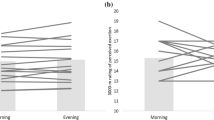Abstract
The aim of this study was to examine the heart rate (HR) response to Olympic windsurfing competition and to check if there was any correlation between racing HR, performance, and the variables measured during laboratory maximal exercise. Ten elite windsurfers [age: 20.93 (3.46) years; height: 178.10 (6.34) cm; body mass: 66.79 (5.90) kg] performed a laboratory maximal oxygen consumption (VO2max) trial and national windsurf competitions wearing a HR monitor. One hundred and forty-three individual races were examined. Racing HR was expressed as a percentage of (1) HRmax (maximal treadmill HR) and (2) HRreserve (HRmax−HRrest). The performance (racing classification: RC, which is inversely proportional to performance) was significantly correlated to the racing HR response in both light wind (LW): LW−RC=−0.12(%HRreserve)+13.03; r=−0.71, r 2=0.50, p<0.001, and medium wind (MW): MW−RC=−0.11(%HRreserve)+10.99; r=−0.66, r 2=0.43, p<0.001. The results showed similar correlations between performance and %HRmax. Post racing lactate concentration was higher in LW compared to MW [7.14 (0.21) and 5.18 (2.02) mmol·l−1, respectively]. There was a negative correlation between the highest racing HR (%HRreserve) of each athlete and the second ventilatory threshold expressed as a percentage of VȮ2max (r=–0.71, p<0.05). To summarize, this study showed that light and medium wind Olympic windsurfing performances are highly dependent on the capacity of the athlete to maintain a high HR for long periods of time. Furthermore, windsurfing is highly dependent on the athlete's physical fitness level as shown by the correlations between racing HRs and laboratory physiological variables.


Similar content being viewed by others
References
American College of Sports Medicine (ACSM) (1978) The recommended quantity and quality of exercise for developing and maintaining fitness in healthy adults (position statement). Med Sci Sports 10:II–X
American College of Sports Medicine (ACSM) (1986) Guidelines for exercise testing and prescription, 3rdedn. Lea and Febiger, Philadelphia, p 168
Beaver WL, Wasserman K, Whipp BJ (1986) A new method for detecting anaerobic threshold by gas exchange. J Appl Physiol 60:2020–2027
Billat VL, Koralsztein JP (1996) Significance of the velocity at V̇O2max and time to exhaustion at this velocity. Sports Med 22:90–108
Brooks GA (1991) Current concepts in lactate exchange. Med Sci Sports Exerc 23:895–906
Chamari K, Ahmaidi S, Fabre C, Ramonatxo M, Prefaut C (1995) Pulmonary gas exchange and ventilatory responses to brief intense intermittent exercise in young trained and untrained adults. Eur J Appl Physiol . 70:442–450
Chardigny JM, Moreau D, Chedeville J, Meurgey B (1990) Epreuve d'effort en planche à voile et lactatémie. In Eléments de Recherche en Voile. Mémento Technique. Publication Fédération Française de Voile. pp 65–73
Dansou P, Oddou MF, Delaire M, Therminarias A (2001) Dépense énergétique aérobie au cours d'un match de tennis, du laboratoire au terrain. Sci Sports 16:16–22
Dassonville J, Beillot J, Lessard Y, Jan J, André AM, Le Pourcelet C, Rochongar P, Carré F (1998) Blood lactate concentrations during exercise: effect of sampling site and exercise mode. J Sports Med Phys Fitness 38:39–46
De Vito G, Di Filippo L, Rodio A, Felici F, Madaffari A (1997) Is the Olympic boardsailor an endurance athlete? Int J Sports Med 18:281–284
Gilman MB (1996) The use of heart rate to monitor the intensity of endurance training. Sports Med 21:73–79
Gilman MB, Wells CL (1993) The use of heart rates to monitor exercise intensity in relation to metabolic variables. Int J Sports Med 14:339–344
Guével A, Maïsetti O, Prou E, Dubois JJ, Marini JF (1999) Heart rate and blood lactate responses during competitive Olympic boardsailing. J Sports Sci 17:135–141
Guével A, Hogrel JY, Marini JF (2000) Fatigue elbow flexors during repeated flexion–extension cycles: effects of movement strategy. Int J Sports Med 21:492–498
International Sailing Association of Federations (ISAF). International Racing Rules 1992–1996 and 1996–2000
Léger L (1994) Significations et limites de l'utilisation de la fréquence cardiaque dans le contrôle de l'entraînement In: Cazorla G, Robert G (eds) Actes du troisième colloque international de la Guadeloupe. Actshng et Areaps
Londeree BR, Thomas TR, Ziogas G, Smith TD, Zhang Q (1995) %V̇O2max versus %HRmax regressions for six modes of exercise. Med Sci Sports Exerc 27:458–461
Paavolaïnen L, Häkkinen K, Hämäläinen I, Nummela A, Rusko H (1999) Explosive-stregth training improves 5-km running time by improving running economy and muscle power. J Appl Physiol 86:527–1533
Vogiatzis I, De Vito G, Rodio A, Madaffari A, Marchetti A (2002) The physiological demands of sail pumping in Olympic level windsurfers. Eur J Appl Physiol 86:450–454
Whipp BJ, Ward SA, Lamarra N, Davis JA, Wasserman K (1982) Parameters of ventilatory and gas exchange dynamics during exercise. J Appl Physiol 52:1506–1513
Acknowledgements
The authors would like to thank Dr. Jean-Claude Chatard for his valuable help and Tony Philp, Gaby Mkaouar, and Hajer Amri for their technical support.
Author information
Authors and Affiliations
Corresponding author
Rights and permissions
About this article
Cite this article
Chamari, K., Moussa-Chamari, I., Galy, O. et al. Correlation between heart rate and performance during Olympic windsurfing competition. Eur J Appl Physiol 89, 387–392 (2003). https://doi.org/10.1007/s00421-003-0808-4
Accepted:
Published:
Issue Date:
DOI: https://doi.org/10.1007/s00421-003-0808-4




